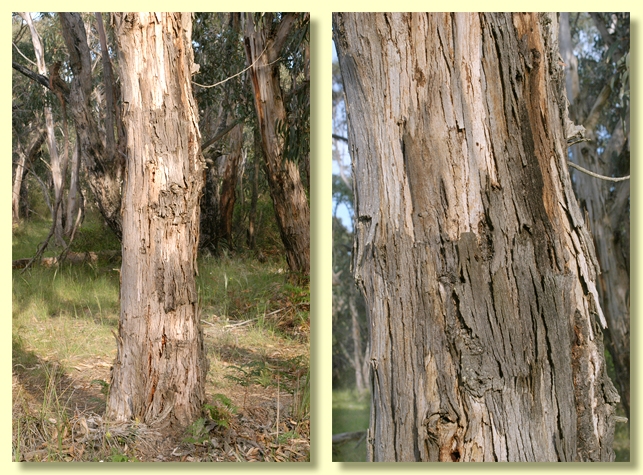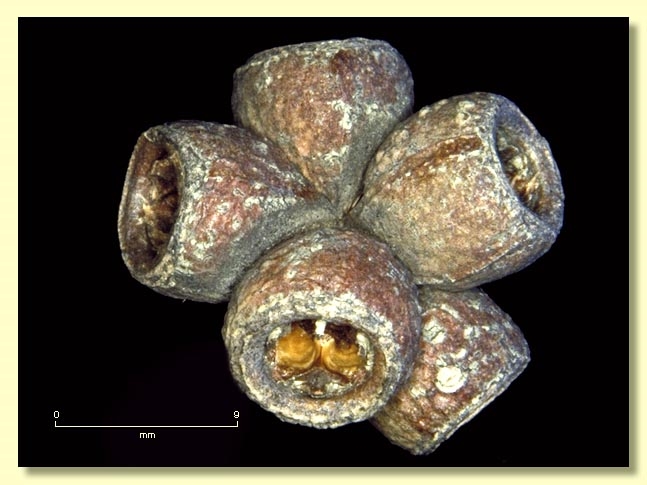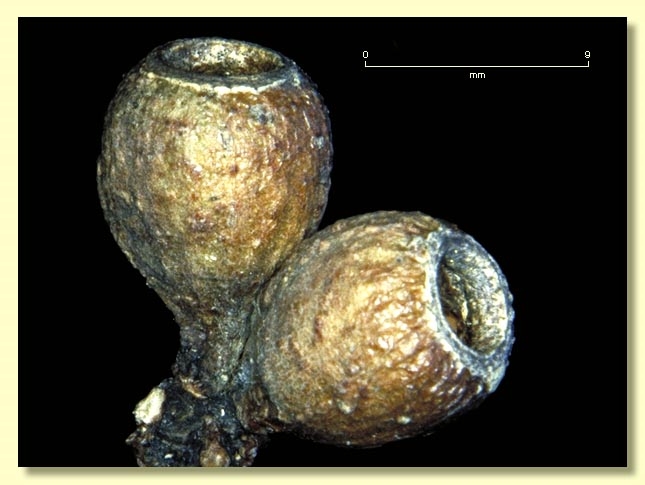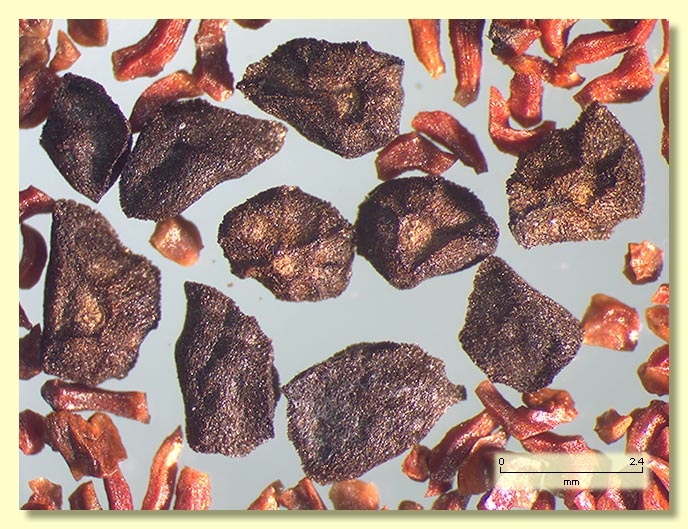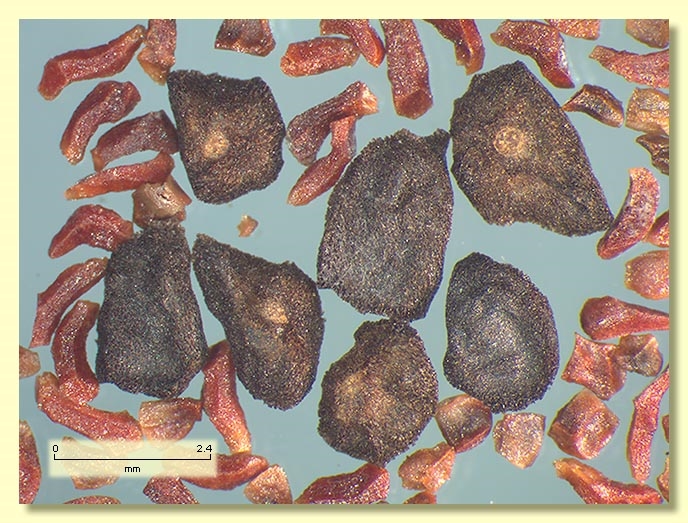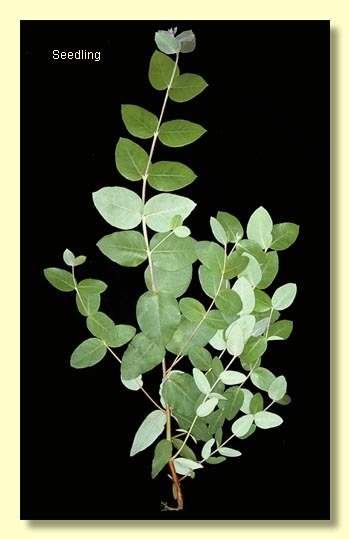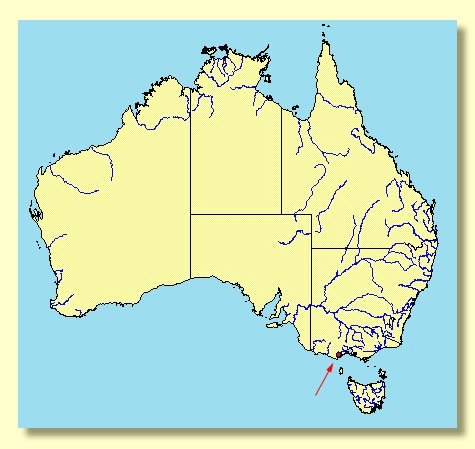Euclid - Online edition
Eucalyptus litoralis
Eucalyptus | Symphyomyrtus | Maidenaria | Euryotae | Globulares | Remanentes
T: Victoria, Coalmine Road, Anglesea, 10 July 2000, K.Rule 0097; holo: MEL; iso: AD, CANB, NSW.
Eucalyptus sp. aff. goniocalyx(= M.I.H. Brooker 11794) in Brooker et al. "EUCLID: Eucalypts of south-eastern Australia" edition 1 (1997, revised 2000) and Brooker et al. "EUCLID: Eucalypts of southern Australia" edition 2 (2002).
Bark rough but thin and more or less loose on part or all of trunk, fibrous, grey-brown; branches smooth pale grey to creamy.
Juvenile growth (coppice or field seedlings to 50 cm): stems square in cross-section, sometimes winged, slightly glaucous, slightly warty or smooth; juvenile leaves opposite and sessile for many pairs, highly variable in shape and size, from orbicular to ovate, 3.5–12.5 cm long, 3–11.5 cm wide, bases amplexicaul, apex rounded to pointed (mucronate), margin entire or subcrenulate, slightly discolorous, glossy green above, sometimes slightly glaucous below, usually thick-textured.
Adult leaves alternate, petiole 2–4 cm long; blade lanceolate to falcate, 12–21(35) cm long, 2–3.3(4.5) cm wide, base tapering to petiole or rounded, concolorous, glossy, green, side-veins greater than 45° to midrib, densely reticulate, intramarginal vein parallel to and well removed from margin, oil glands mostly island.
Inflorescence axillary unbranched, peduncles broad, 1–2.4 cm long, buds 7 per umbel, sessile or on pedicels to 0.4 cm long. Mature buds cylindrical to more or less fusiform, usually with faint longitudinal angles, 1–1.4 cm long, 0.4–0.6 cm wide, scar present, operculum conical, stamens irregularly flexed, anthers cuneate to oblong, versatile, dorsifixed, dehiscing by longitudinal slits (non-confluent), style long, stigma blunt, locules 3 or 4, the placentae each with 4 vertical ovule rows. Flowers white.
Fruit sessile or pedicellate (pedicels 0–0.3 cm long), cylindrical, cup-shaped or barrel-shaped, 0.7–1.1(1.3) cm long, 0.7–1.1 cm wide, often angled longitudinally, disc descending, valves 3 or 4, near rim level or enclosed.
Seeds dark grey, brown or black, 2–3 mm long, ovoid to flattened-ovoid, often pointed at one end, sometimes lacunose, dorsal surface shallowly pitted, hilum ventral.
Cultivated seedlings (measured at ca node 10): cotyledons bilobed; stems rounded or square in cross-section, glaucous; leaves sessile and opposite for many nodes, ovate to orbicular, 5.5–6.5 cm long, 3–6 cm wide, base amplexicaul, margin subcrenulate or entire, apex broadly pointed, glaucous at first becoming green and slightly to quite glossy.
Flowering has been recorded in March.
Woodland trees of moderate size, endemic to Victoria, occurring on sandstone hills quite near the sea, from Anglesea south-west to Airys Inlet and Lorne. Eucalyptus litoralis has very thin loose rough bark over part or all of the trunk but has smooth-barked branches, glossy green adult leaves with dense venation, cylindrical-fusiform but angular buds in clusters of seven, and cylindrical to barrel-shaped fruit smooth or weakly longitudinally angled. The juvenile growth is coarse with square stems and large rounded thick-textured that are leaves opposite and sessile.
Along this stretch of the Victorian coast the densely reticulate adult leaves and coarse juvenile growth, combined with the 7-budded umbels, large more or less sessile fruit and smooth-barked branches will separate E. litoralis from all other species. On wetter sites the tall, smooth-barked blue-gum Eucalyptus globulus subsp. globulus occurs and differs in having solitary buds (rarely in 3s) that are short, broad, warty, often waxy and have a pronounced bump on the operculum. The closest relative of E. litoralis in this general area is E. cypellocarpa, a tall forest tree with predominantly smooth bark, occurring on wetter, more sheltered sites, and differing further in having slightly smaller buds and fruit (but overlapping in dimensions with those of E. litoralis), thinner-textured juvenile leaves although still opposite and on square stems. Another closely related species, E. goniocalyx subsp. goniocalyx, is a woodland tree occurring much further inland in Victoria and differs in having glaucous thin-textured juveniles (rarely non-glaucous) and more extensive and thicker rough bark, often extending to the small branches. A fourth rough-barked species in this group, E. nortonii, has glaucous branchlets, buds and fruit and the adult leaves may also be glaucous; in Victoria it occurs in central and eastern parts, not at the coast.
E. litoralis was for many years regarded by some botanists as a hybrid between E. goniocalyx and another species, or an intermediate form between E. goniocalyx and E. cypellocarpa , but it seems to be relatively constant in morphology in both adult and juvenile phases. It is morphologically very close to E. cypellocarpa in particular and could be regarded as a coarse coastal form of that species, consistently differing only in the loose thin rough bark, length of the mature buds and the shape of the juvenile leaves.
Eucalyptus litoralis was described subsequent to the classification of the eucalypts published by Brooker (2000). It belongs in Eucalyptus subgenus Symphyomyrtus section Maidenaria, a large group of species more or less restricted to south-eastern Australia, characterised by bilobed cotyledons, simple axillary inflorescences, buds with two opercula, stamens with versatile anthers and flattened seeds with a ventral hilum. Within this section, E. litoralis belongs in series Globulares subseries Remanentes, having sessile, juvenile leaves opposite for many pairs on square, more or less winged, stems, small buds in clusters of 7 and small fruit with a descending disc. Species in subseries Remanentes are E. nitens, E. denticulata, E. quadrangulata, E. cypellocarpa, E. litoralis, E. retinens, E. volcania, E. nortonii, E. goniocalyx, E. banksii.


